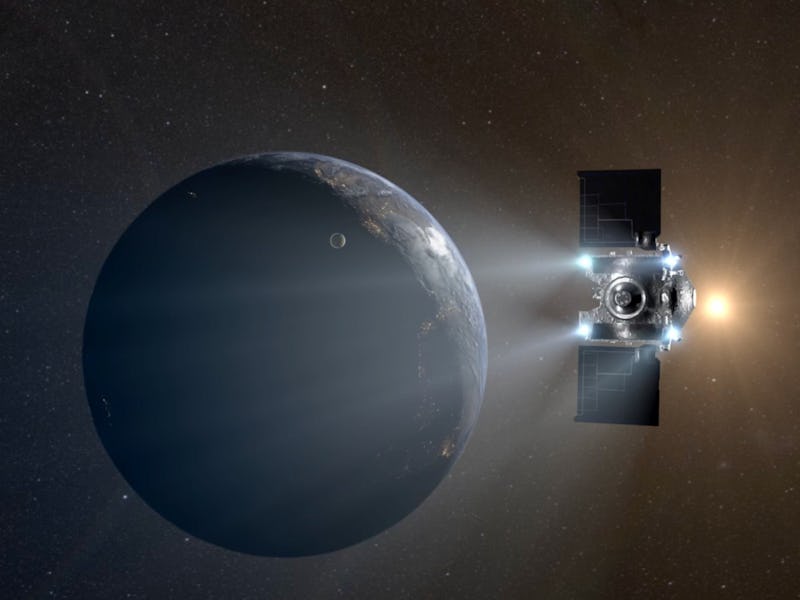NASA Redirected Its Asteroid Mission To This Menacing Object Near Earth
Apophis is the next target for this historic mission.

Apophis is an asteroid with a loathsome name. It’s borrowed from the serpentine Egyptian god of evil for what seemed like very apt reasons two decades ago when astronomers first discovered it.
Apophis once sourced an existential fear: a violent asteroid impact in 2029. Now, though, current predictions say that’s barely a remote possibility. The asteroid will not strike Earth this century, but it will come intriguingly close. On April 13, 2029, the infamous space object will be visible with binoculars east of the Atlantic Ocean while it cruises closer than geostationary weather satellites.
Now, a creative team at NASA and the University of Arizona has redirected a spacecraft to study Apophis like never before.
An early concept of what asteroid Apophis might look like.
On September 24, NASA’s OSIRIS-REx mission turned a page when it completed its lofty goal: a 7-year journey through space to a primordial asteroid called Bennu, where it collected rubble from its surface and delivered the parcel to Earth. When the asteroid sample capsule landed in Utah last month, NASA joined the club that was, up until then, only occupied by the Japan Aerospace Exploration Agency (JAXA), whose Hayabusa spacecraft fleet had sampled asteroids Itokawa and Ryugu.
Now, OSIRIS-REx principal investigator Dante Lauretta and his team are looking to the future and it lies at Apophis. Lauretta tells Inverse that the menacing object wound up, rather serendipitously, to be the best candidate for OSIRIS-REx’s extended mission.
OSIRIS-REx stands for Origins, Spectral Interpretation, Resource Identification, and Security–Regolith Explorer. Its samples, now housed in NASA’s Johnson Space Center in Houston, are “grandfather rocks,” Lauretta says. The mission was looking for pristine crumbs left behind by the formation of the Solar System.
The OSIRIS-REx capsule watches its Bennu asteroid sample capsule make its way to Earth.
Now, the spacecraft is called OSIRIS-APEX, for OSIRIS-Apophis Explorer.
“We can go into orbit, and we can do a full proximity operation mission, minus the sample collection,” Lauretta says. The hardware that gathered asteroid material is back on Earth, no longer on the spacecraft.
Again, because this probably needs repeating: Earth will — thankfully — be unaffected by Apophis’ close approach on April 13, 2029. When the asteroid was discovered in 2004, concerns grew that the 1,100-foot-long asteroid would, according to NASA, “come uncomfortably close” in 2029. Subsequent optical and radar data from Earth later revealed that wouldn’t be the case. That analysis also showed that Apophis won’t be a danger when it flies by again in 2068, either. Predictions indicate Apophis won’t hit Earth for at least the next century. The asteroid has been scratched off the impact risk list that NASA’s Center for Near-Earth Object Studies maintains.
Now, instead of woe, the 2029 close approach will inspire exploration. The asteroid flyby will facilitate OSIRIS-APEX’s aim.
“Gravity assists are like those speed-up moves in video games. If you hit the right spot, you go zooming off in a different direction,” Lauretta says.
He credits the incredible talents of NASA’s flight dynamics team for determining that OSIRIS-REx could have a second life around another rock.
“All we need to do, and it’s not easy, but they figured it out, is to get the spacecraft near the same place in Earth’s gravity field that Apophis is when doing a close approach [in 2029]. They’ll both get bent in the same way and then the spacecraft can rendezvous maybe a few weeks later,” Lauretta says.
Earth will be okay when Apophis approaches within just 32,000 kilometers. But the asteroid itself may not. The close approach “may actually trigger landslides and other active geologic processes [on the asteroid] because of the tidal force of our planet,” says Lauretta.
This 2019 video from NASA shows the path along Earth where Apophis will be visible on April 13, 2029.
The flyby could also change Apophis’ trajectory around the Sun. That’s where OSIRIS-APEX will come in. It will study the asteroid’s topography and render astronomers the best view of it yet.
The stony object is currently thought to be shaped like a peanut, wobble slightly as it rotates once every 30 hours, and rock back and forth, all of which affect its journey through the inner Solar System.
Astronomers have already predicted enduring changes. Apophis is currently part of the Aten group of asteroids, whose orbits create a shape in space slightly smaller than the one drawn by Earth. But that will end soon.
“As a result of its close encounter with Earth in 2029, the asteroid's orbit will be widened to become slightly larger than the width of Earth's orbit. At this point, it will be reclassified from the Aten group to the ‘Apollo’ group (the group of Earth-crossing asteroids with orbits wider than 1 AU),” according to NASA. (AU, shorthand for astronomical unit, is the distance between the Sun and Earth.)
Apophis’ approach is invigorating at best, the stuff of nightmares (remember, these are never real) at its worst. Lauretta and colleagues will be watching closely as their history-making spacecraft, already a champion for asteroid exploration, performs the best sequel ever.